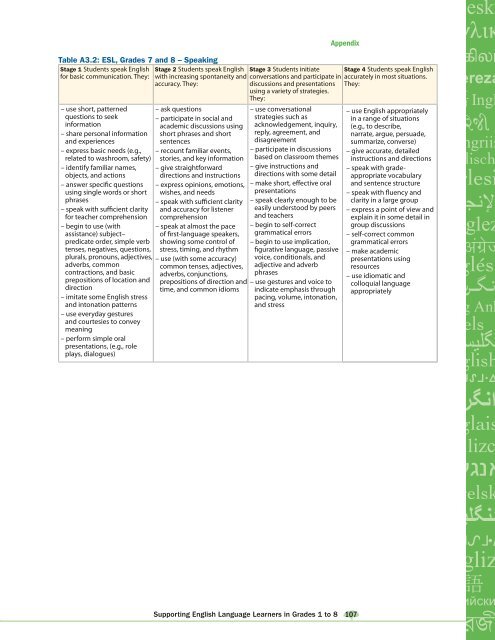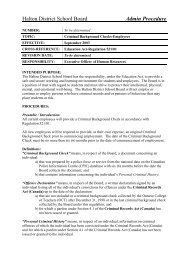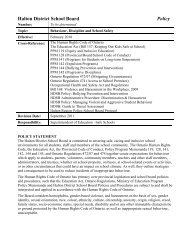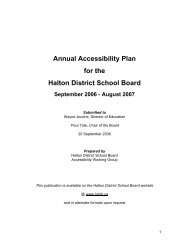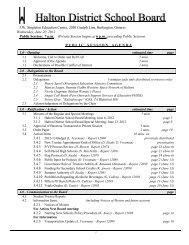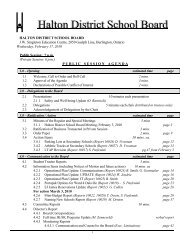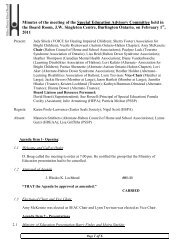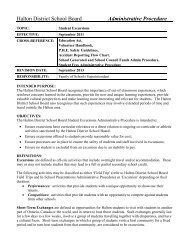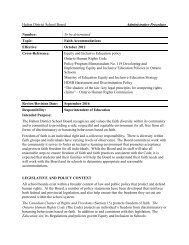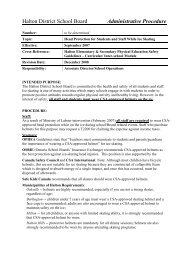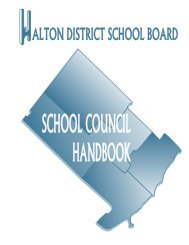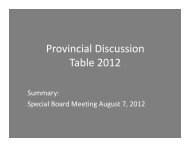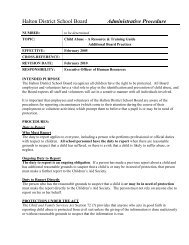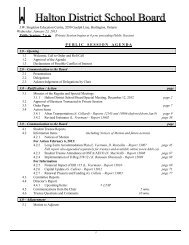Supporting English Language Learners in Grades 1 to 8
Supporting English Language Learners in Grades 1 to 8
Supporting English Language Learners in Grades 1 to 8
Create successful ePaper yourself
Turn your PDF publications into a flip-book with our unique Google optimized e-Paper software.
Table A3.2: ESL, <strong>Grades</strong> 7 and 8 – Speak<strong>in</strong>g<br />
Stage 1 Students speak <strong>English</strong><br />
for basic communication. They:<br />
– use short, patterned<br />
questions <strong>to</strong> seek<br />
<strong>in</strong>formation<br />
– share personal <strong>in</strong>formation<br />
and experiences<br />
– express basic needs (e.g.,<br />
related <strong>to</strong> washroom, safety)<br />
– identify familiar names,<br />
objects, and actions<br />
– answer specific questions<br />
us<strong>in</strong>g s<strong>in</strong>gle words or short<br />
phrases<br />
– speak with sufficient clarity<br />
for teacher comprehension<br />
– beg<strong>in</strong> <strong>to</strong> use (with<br />
assistance) subject–<br />
predicate order, simple verb<br />
tenses, negatives, questions,<br />
plurals, pronouns, adjectives,<br />
adverbs, common<br />
contractions, and basic<br />
prepositions of location and<br />
direction<br />
– imitate some <strong>English</strong> stress<br />
and <strong>in</strong><strong>to</strong>nation patterns<br />
– use everyday gestures<br />
and courtesies <strong>to</strong> convey<br />
mean<strong>in</strong>g<br />
– perform simple oral<br />
presentations, (e.g., role<br />
plays, dialogues)<br />
Stage 2 Students speak <strong>English</strong><br />
with <strong>in</strong>creas<strong>in</strong>g spontaneity and<br />
accuracy. They:<br />
– ask questions<br />
– participate <strong>in</strong> social and<br />
academic discussions us<strong>in</strong>g<br />
short phrases and short<br />
sentences<br />
– recount familiar events,<br />
s<strong>to</strong>ries, and key <strong>in</strong>formation<br />
– give straightforward<br />
directions and <strong>in</strong>structions<br />
– express op<strong>in</strong>ions, emotions,<br />
wishes, and needs<br />
– speak with sufficient clarity<br />
and accuracy for listener<br />
comprehension<br />
– speak at almost the pace<br />
of first-language speakers,<br />
show<strong>in</strong>g some control of<br />
stress, tim<strong>in</strong>g, and rhythm<br />
– use (with some accuracy)<br />
common tenses, adjectives,<br />
adverbs, conjunctions,<br />
prepositions of direction and<br />
time, and common idioms<br />
Stage 3 Students <strong>in</strong>itiate<br />
conversations and participate <strong>in</strong><br />
discussions and presentations<br />
us<strong>in</strong>g a variety of strategies.<br />
They:<br />
– use conversational<br />
strategies such as<br />
acknowledgement, <strong>in</strong>quiry,<br />
reply, agreement, and<br />
disagreement<br />
– participate <strong>in</strong> discussions<br />
based on classroom themes<br />
– give <strong>in</strong>structions and<br />
directions with some detail<br />
– make short, effective oral<br />
presentations<br />
– speak clearly enough <strong>to</strong> be<br />
easily unders<strong>to</strong>od by peers<br />
and teachers<br />
– beg<strong>in</strong> <strong>to</strong> self-correct<br />
grammatical errors<br />
– beg<strong>in</strong> <strong>to</strong> use implication,<br />
figurative language, passive<br />
voice, conditionals, and<br />
adjective and adverb<br />
phrases<br />
– use gestures and voice <strong>to</strong><br />
<strong>in</strong>dicate emphasis through<br />
pac<strong>in</strong>g, volume, <strong>in</strong><strong>to</strong>nation,<br />
and stress<br />
Appendix<br />
Stage 4 Students speak <strong>English</strong><br />
accurately <strong>in</strong> most situations.<br />
They:<br />
– use <strong>English</strong> appropriately<br />
<strong>in</strong> a range of situations<br />
(e.g., <strong>to</strong> describe,<br />
narrate, argue, persuade,<br />
summarize, converse)<br />
– give accurate, detailed<br />
<strong>in</strong>structions and directions<br />
– speak with gradeappropriate<br />
vocabulary<br />
and sentence structure<br />
– speak with fluency and<br />
clarity <strong>in</strong> a large group<br />
– express a po<strong>in</strong>t of view and<br />
expla<strong>in</strong> it <strong>in</strong> some detail <strong>in</strong><br />
group discussions<br />
– self-correct common<br />
grammatical errors<br />
– make academic<br />
presentations us<strong>in</strong>g<br />
resources<br />
– use idiomatic and<br />
colloquial language<br />
appropriately<br />
<strong>Support<strong>in</strong>g</strong> <strong>English</strong> <strong>Language</strong> <strong>Learners</strong> <strong>in</strong> <strong>Grades</strong> 1 <strong>to</strong> 8<br />
107


